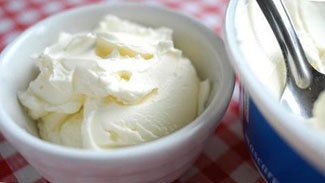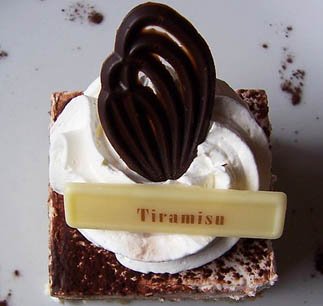Mascarpone cheese nutrition facts
Mascarpone is a fresh, soft, and creamy cheese, and unlike other cheeses that are obtained from milk, it is processed from the acid-coagulation of milk cream.
It was first manufactured in the 16th or 17th century in Lombardy, Italy. Traditionally mascarpone is made from cow’s milk cream and has a butterfat content of around 75%.
 |
| Fresh Mascarpone cheese. |
Mascarpone has a mild taste, making it an ideal base for many different dishes and incorporating various flavors and ingredients.
Processing of Mascarpone cheese:
Traditionally, Mascarpone is made from fresh cream that rises to the top in the next morning after allowing the whole cow’s milk to stand overnight in the Parmigiano-Reggiano cheese manufacturing units.
It is often recognized as “Italian Cream Cheese” for its creamy consistency and milky-white color. It is very simple to make at home, requiring only a few ingredients and equipment.
1. Mascarpone is a soft, cream-type cheese produced by heat-acid coagulation of milk cream.
2. The general procedure of cooking the cream, adding acid, and draining the curds from the whey.
3. Initially, the cream is obtained from the centrifugation of the milk or allowing the cream to rise naturally overnight.
4. Then, heat the cream to a temperature of 90 ° C. Add acid (such as vinegar, citric, or lactic acid). Wait for the newly formed curd to be separated from the whey. The mixture is left to rest for 8-12 hours in a cool place.
Nutrition Facts and Health Benefits of Mascarpone Cheese
Since American mascarpone cheese is manufactured utilizing milk cream, it is very high in calories, fat and fat-soluble vitamins. 100g mascarpone cheese holds 435 calories and 45.5 g of total fats.
Nonetheless, it is one of the nutritionally dense dairy items that composes high amounts of vitamin B-12 and fat-soluble vitamins, and average levels of protein, and minerals.
It is a very rich source of vitamin-A (1373 IU or 46% of recommended daily amounts/ 100g).
Mascarpone cheese, being a dairy product, is free of gluten. In gluten-sensitive (Celiac disease) persons, it is another important source of gluten-free food items rich in protein, minerals, and vitamins.
During the curdling process, all the major milk constituents such as lactose, milk lipids, and milk proteins, undergo biochemical changes into more easily digestible and health-benefiting compounds.
Mascarpone cheese contains moderate amounts of dietary calcium and phosphorous (16% and 16.5% respectively), which play an important role in bone strengthening and growth, especially in children.
Mascarpone, a cream-based dairy product, contains only a small amount of protein (4.6 g/100 g). Nonetheless, it is complete in all essential amino acids needed for growth and development and stay healthy.
| Principle | Nutrient Value | Percent of RDA |
|---|---|---|
| Energy | 435 Kcal | 4.2% |
| Carbohydrates | 4.3 g | 3.3% |
| Protein | 4.6 g | % |
| Total Fat | 44.5 g | 172% |
| Saturated fats | 21.04 g | 210% |
| Cholesterol | 123 g | 41% |
| Dietary Fiber | 0 g | 0% |
| Vitamins | ||
| Folates | 11 μg | 2.25% |
| Niacin | 1.8 mg | <1% |
| Pyridoxine | 0.056 mg | 4% |
| Riboflavin | 0.22 mg | 18% |
| Thiamin | 0.04 mg | 2% |
| Vitamin-A | 1373 IU | 46% |
| Vitamin-B12 | 0.6 μg | 25% |
| Vitamin-C | 0 mg | 0% |
| Vitamin-D | 0.3 IU | <1% |
| Vitamin-E | 1.14 mg | 8% |
| Electrolytes | ||
| Sodium | 70 mg | 4.75% |
| Potassium | 137 mg | 3% |
| Minerals | ||
| Calcium | 161 mg | 16% |
| Copper | tr | - |
| Iron | tr | - |
| Magnesium | 11 mg | 3% |
| Manganese | tr | - |
| Phosphorus | 116 mg | 16.5% |
| Zinc | 0.7 mg | 6% |
Buying
Fresh mascarpone is readily available year-round in U.S. groceries. In the Po Valley region of northern Italy, it is also called Mascherpa or Mascherpone.
Buy buttery, rich, creamy fresh from authentic sources and check for use by date.
Storing
Being a gentle dairy product, mascarpone cheese is highly perishable. If you prepare it at home, make small batches frequently and store it well in the fridge for up to a week.
Food uses
Mascarpone has a smooth and creamy texture due to its high butterfat content. It has a rich, buttery flavor with a slightly sweet and tangy finish due to the addition of acid during the curdling process. This cheese can be used in a variety of sweet and savory recipes.
Here are some serving tips
 |
| Tiramisu cheesecake. Courtesy: Daniel |
Mascarpone is a main ingredient in the delicious Italian desserts tiramisu, cheesecake, zabaglione (Zabaione).
It is chiefly used as a topping spread in many desserts like cakes, donuts, bagels, or cream-filled/stuffed in bread, croquettes, muffins, cookies, etc.
In the northern Lombardy region of Italy, smoked mascarpone with anchovies topped on rye bread is a specialty dish.
Substitute mascarpone cheese in recipes that call for traditional cream cheese or butter.
It can be employed in chicken/vegetable stuffing, dips, sauces, and soups.
Safety profile
Mascarpone is high caloric content cheese composing about 435 Kcal/100 grams. It also composes 44.5 g of fat content, out of which, 21.04 g of saturated fats.
Dieticians often do not recommend it for those on a low-calorie diet where it can be worthily replaced by artisan ricotta and low-fat cream cheese.
Also read ≻≻
≺≺Cream cheese nutrition facts.
≺≺Ricotta nutrition facts.
≺≺Mozzarella cheese nutrition facts.
≻≻-Back to Dairy products from Mascarpone cheese nutrition facts.
≻≻-Back to Home page.
Further Resources:
Composition of foods integrated dataset (CoFID). (Excel sheets-Sl No-617, opens in new window).
Mastering Mascarpone: What it takes to make a perfect batch of Mascarpone Cheese (opens in new window).
Canadian dairy Commission. (opens in new window).